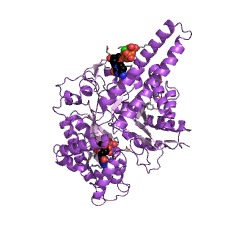| Synonyms |
2′-deoxyribonucleoside-triphosphate:oxidized-thioredoxin 2′-oxidoreductase, adenosylcobalamin-dependent ribonucleoside-triphosphate reductase, class Ib ribonucleotide reductase, class Ib RNR, class II ribonucleotide reductase, class II RNR, class III ribonucleotide reductase, class III RNR, More, nrdD, nucleoside triphosphate reductase, ribonucleoside triphosphate reductase, ribonucleotide diphosphate reductase, ribonucleotide reductase, RNR, RNR class Ia, RNR2, RTPR |
| Comments |
The enzyme, characterized from the bacterium Lactobacillus leichmannii, is similar to class II ribonucleoside-diphosphate reductase (cf. EC 1.17.4.1). However, it is specific for the triphosphate versions of its substrates. The enzyme contains an adenosylcobalamin cofactor that is involved in generation of a transient thiyl (sulfanyl) radical on a cysteine residue. This radical attacks the substrate, forming a ribonucleotide 3′-radical, followed by water loss to form a ketyl (¦Á-oxoacyl) radical. The ketyl radical is reduced to 3′-keto-deoxynucleotide concomitant with formation of a disulfide anion radical between two cysteine residues. A proton-coupled electron-transfer from the disulfide radical to the substrate generates a 3′-deoxynucleotide radical, and the the final product is formed when the hydrogen atom that was initially removed from the 3′-position of the nucleotide by the thiyl radical is returned to the same position. The disulfide bridge is reduced by the action of thioredoxin. cf. EC 1.1.98.6, ribonucleoside-triphosphate reductase (formate). |

